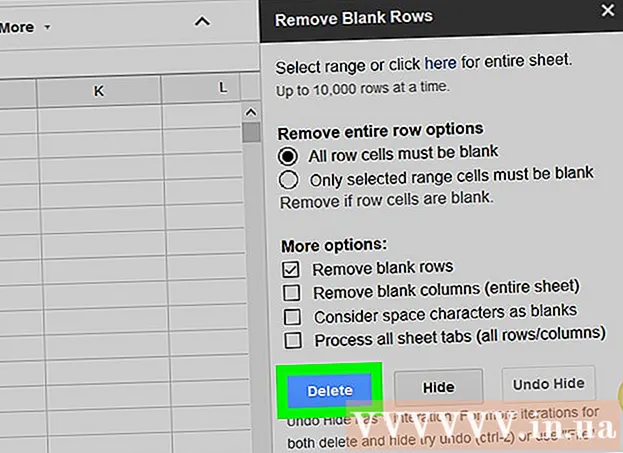Author:
Helen Garcia
Date Of Creation:
15 April 2021
Update Date:
1 July 2024

Content
- Steps
- Method 1 of 3: Rational Expression - Monomial
- Method 2 of 3: Fractional Rational Expression (Numerator - Monomial, Denominator - Polynomial)
- Method 3 of 3: Fractional Rational Expression (Numerator and Denominator are polynomials)
- What do you need
Simplification of rational expressions is a fairly simple process if it is a monomial, but more effort will have to be done if the rational expression is a polynomial. This article will show you how to simplify rational expression depending on its type.
Steps
Method 1 of 3: Rational Expression - Monomial
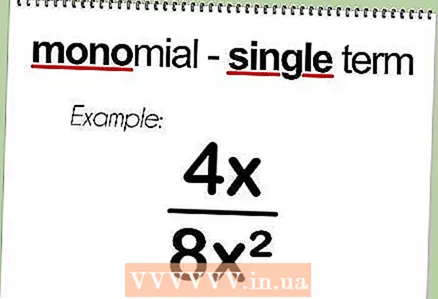 1 Examine the problem. Rational expressions - monomials are the easiest to simplify: all you have to do is reduce the numerator and denominator to non-cancellable values.
1 Examine the problem. Rational expressions - monomials are the easiest to simplify: all you have to do is reduce the numerator and denominator to non-cancellable values. - Example: 4x / 8x ^ 2
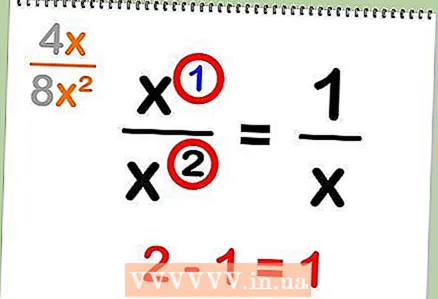 2 Reduce the same variables. If a variable is in both the numerator and denominator, you can abbreviate that variable accordingly.
2 Reduce the same variables. If a variable is in both the numerator and denominator, you can abbreviate that variable accordingly. - If the variable is in both the numerator and the denominator to the same extent, then such a variable is canceled out completely: x / x = 1
- If the variable is in both the numerator and the denominator in different degrees, then such a variable is canceled accordingly (the smaller indicator is subtracted from the larger one): x ^ 4 / x ^ 2 = x ^ 2/1
- Example: x / x ^ 2 = 1 / x
 3 Reduce the coefficients to non-reducible values. If the numerical coefficients have a common factor, divide the factors in both the numerator and denominator by it: 8/12 = 2/3.
3 Reduce the coefficients to non-reducible values. If the numerical coefficients have a common factor, divide the factors in both the numerator and denominator by it: 8/12 = 2/3. - If the coefficients of the rational expression do not have common divisors, then they do not cancel: 7/5.
- Example: 4/8 = 1/2.
 4 Write down your final answer. To do this, combine the abbreviated variables and the abbreviated coefficients.
4 Write down your final answer. To do this, combine the abbreviated variables and the abbreviated coefficients. - Example: 4x / 8x ^ 2 = 1 / 2x
Method 2 of 3: Fractional Rational Expression (Numerator - Monomial, Denominator - Polynomial)
 1 Examine the problem. If one part of a rational expression is a monomial and the other is a polynomial, you may need to simplify the expression in terms of some divisor that can be applied to both the numerator and denominator.
1 Examine the problem. If one part of a rational expression is a monomial and the other is a polynomial, you may need to simplify the expression in terms of some divisor that can be applied to both the numerator and denominator. - Example: (3x) / (3x + 6x ^ 2)
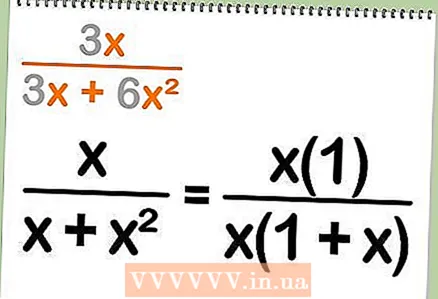 2 Reduce the same variables. To do this, place the variable outside the parentheses.
2 Reduce the same variables. To do this, place the variable outside the parentheses. - This will only work if the variable contains each term of the polynomial: x / x ^ 3-x ^ 2 + x = x / (x (x ^ 2-x + 1))
- If any member of the polynomial does not contain a variable, then you cannot take it outside the brackets: x / x ^ 2 + 1
- Example: x / (x + x ^ 2) = x / (x (1 + x))
 3 Reduce the coefficients to non-reducible values. If the numerical coefficients have a common divisor, divide those coefficients in both the numerator and denominator by it.
3 Reduce the coefficients to non-reducible values. If the numerical coefficients have a common divisor, divide those coefficients in both the numerator and denominator by it. - Note that this will only work if all coefficients in the expression have the same divisor: 9 / (6 - 12) = (3 * 3) / (3 / (2 - 4))
- This will not work if any of the coefficients in the expression do not have such a divisor: 5 / (7 + 3)
- Example: 3 / (3 + 6) = (3 * 1) / (3 (1 + 2))
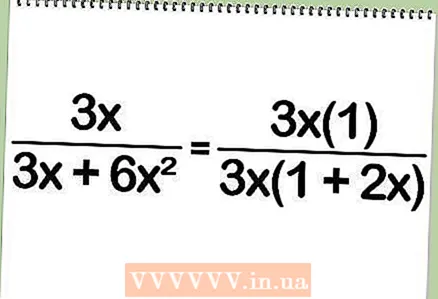 4 Combine variables and coefficients. Combine the variables and coefficients, taking into account the terms outside the brackets.
4 Combine variables and coefficients. Combine the variables and coefficients, taking into account the terms outside the brackets. - Example: (3x) / (3x + 6x ^ 2) = (3x * 1) / (3x (1 + 2x))
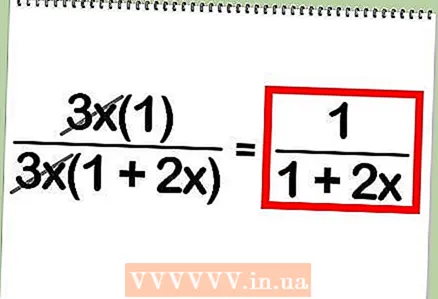 5 Write down your final answer. To do this, shorten such terms.
5 Write down your final answer. To do this, shorten such terms. - Example: (3x * 1) / (3x (1 + 2x)) = 1 / (1 + 2x)
Method 3 of 3: Fractional Rational Expression (Numerator and Denominator are polynomials)
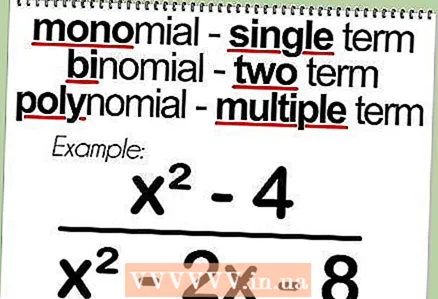 1 Examine the problem. If there are polynomials in both the numerator and the denominator of a rational expression, then you need to factor them.
1 Examine the problem. If there are polynomials in both the numerator and the denominator of a rational expression, then you need to factor them. - Example: (x ^ 2 - 4) / (x ^ 2-2x-8)
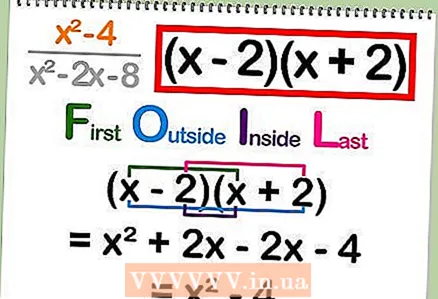 2 Factor out the numerator. To do this, calculate the variable NS.
2 Factor out the numerator. To do this, calculate the variable NS. - Example: (x ^ 2 - 4) = (x - 2) (x + 2)
- To calculate NS you need to isolate the variable on one side of the equation: x ^ 2 = 4.
- Extract the square root of the intercept and from the variable: √x ^ 2 = √4
- Remember that the square root of any number can be positive or negative. Thus, the possible values NS are:-2 and +2.
- So the decomposition (x ^ 2-4) the factors are written in the form: (x-2) (x + 2)
- Verify that the factorization is correct by multiplying the terms in parentheses.
- Example: (x - 2) (x + 2) = x ^ 2 + 2x-2x-4 = x ^ 2-4
- Example: (x ^ 2 - 4) = (x - 2) (x + 2)
 3 Factor the denominator. To do this, calculate the variable NS.
3 Factor the denominator. To do this, calculate the variable NS. - Example: (x ^ 2-2x-8) = (x + 2) (x-4)
- To calculate NS transfer all terms containing a variable to one side of the equation, and free terms to the other: x ^ 2-2x = 8.
- Square half the coefficient of x to the first power and add that value to both sides of the equation:x ^ 2-2x +1 = 8+1.
- Simplify the left side of the equation by writing it as a perfect square: (x-1) ^ 2 = 9.
- Take the square root of both sides of the equation: x-1 = ± √9
- Calculate NS: x = 1 ± √9
- As in any quadratic equation, NS has two possible meanings.
- x = 1-3 = -2
- x = 1 + 3 = 4
- Thus, the polynomial (x ^ 2-2x-8) decomposes (x + 2) (x-4).
- Verify the correct factorization by multiplying the terms in parentheses.
- Example: (x + 2) (x-4) = x ^ 2-4x + 2x-8 = x ^ 2-2x-8
- Example: (x ^ 2-2x-8) = (x + 2) (x-4)
 4 Define similar expressions in the numerator and denominator.
4 Define similar expressions in the numerator and denominator.- Example: ((x-2) (x + 2)) / ((x + 2) (x-4)). In this case, a similar expression is (x + 2).
 5 Write down your final answer. To do this, shorten such expressions.
5 Write down your final answer. To do this, shorten such expressions. - Example: (x ^ 2 - 4) / (x ^ 2-2x-8) = ((x-2) (x + 2)) / ((x + 2) (x-4)) = (x-2 ) / (x-4)
What do you need
- Calculator
- Pencil
- Paper



